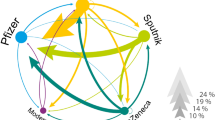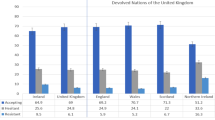Abstract
Clusters of unvaccinated children are particularly susceptible to outbreaks of vaccine-preventable disease1,2. Existing messaging interventions demonstrate short-term success, but some may backfire and worsen vaccine hesitancy3. Values-based messages appeal to core morality, which influences the attitudes individuals then have on topics like vaccination4,5,6,7. We must understand how underlying morals, not just attitudes, differ by hesitancy type to develop interventions that work with individual values. Here, we show in two correlational studies that harm and fairness foundations are not significantly associated with vaccine hesitancy, but purity and liberty foundations are. We found that medium-hesitancy parents were twice as likely as low-hesitancy parents to highly emphasize purity (adjusted odds ratio: 2.08; 95% confidence interval: 1.27–3.40). High-hesitancy respondents were twice as likely to strongly emphasize purity (adjusted odds ratio: 2.15; 95% confidence interval: 1.39–3.31) and liberty (adjusted odds ratio: 2.19; 95% confidence interval: 1.50–3.21). Our results demonstrate that endorsement of harm and fairness—ideas often emphasized in traditional vaccine-focused messages—are not predictive of vaccine hesitancy. This, combined with significant associations of purity and liberty with hesitancy, indicates a need for inclusion of broader themes in vaccine discussions. These findings have the potential for application to other health decisions and communications as well.
This is a preview of subscription content, access via your institution
Access options
Access Nature and 54 other Nature Portfolio journals
Get Nature+, our best-value online-access subscription
$29.99 / 30 days
cancel any time
Subscribe to this journal
Receive 12 digital issues and online access to articles
$119.00 per year
only $9.92 per issue
Buy this article
- Purchase on Springer Link
- Instant access to full article PDF
Prices may be subject to local taxes which are calculated during checkout


Similar content being viewed by others
References
Omer, S. B., Salmon, D. A., Orenstein, W. A., deHart, M. P. & Halsey, N. Vaccine refusal, mandatory immunization, and the risks of vaccine-preventable diseases. N. Engl. J. Med. 360, 1981–1988 (2009).
Parker, A. A. et al. Implications of a 2005 measles outbreak in Indiana for sustained elimination of measles in the United States. N. Engl. J. Med. 355, 447–455 (2006).
Nyhan, B., Reifler, J., Richey, S. & Freed, G. L. Effective messages in vaccine promotion: a randomized trial. Pediatrics 133, E835–E842 (2014).
Day, M. V., Fiske, S. T., Downing, E. L. & Trail, T. E. Shifting liberal and conservative attitudes using moral foundations theory. Pers. Soc. Psychol. Bull. 40, 1559–1573 (2014).
Dickinson, J. L., McLeod, P., Bloomfield, R. & Allred, S. Which moral foundations predict willingness to make lifestyle changes to avert climate change in the USA? PLoS ONE 11, e0163852 (2016).
Feinberg, M. & Willer, R. The moral roots of environmental attitudes. Psychol. Sci. 24, 56–62 (2012).
Feinberg, M. & Willer, R. From gulf to bridge: when do moral arguments facilitate political influence? Pers. Soc. Psychol. Bull. 41, 1665–1681 (2015).
Omer, S. B. et al. Nonmedical exemptions to school immunization requirements: secular trends and association of state policies with pertussis incidence. JAMA 296, 1757–1763 (2006).
Omer, S. B., Richards, J. L., Ward, M. & Bednarczyk, R. A. Vaccination policies and rates of exemption from immunization, 2005–2011. N. Engl. J. Med. 367, 1170–1171 (2012).
Wang, E., Clymer, J., Davis-Hayes, C. & Buttenheim, A. Nonmedical exemptions from school immunization requirements: a systematic review. Am. J. Public Health 104, e62–e84 (2014).
Seither, R. et al. Vaccination coverage among children in kindergarten—United States, 2015–2016 school year. MMWR Morb. Mortal. Wkly Rep. 65, 1057–1064 (2016).
Lieu, T. A., Ray, G. T., Klein, N. P., Chung, C. & Kulldorff, M. Geographic clusters in underimmunization and vaccine refusal. Pediatrics 135, 280–289 (2015).
Seither, R. et al. Vaccination coverage among children in kindergarten—United States, 2013–2014 school year. MMWR Morb. Mortal. Wkly Rep. 63, 913–920 (2014).
Birnbaum, M. S., Jacobs, E. T., Ralston-King, J. & Ernst, K. C. Correlates of high vaccination exemption rates among kindergartens. Vaccine 31, 750–756 (2013).
Buttenheim, A., Jones, M. & Baras, Y. Exposure of California kindergartners to students with personal belief exemptions from mandated school entry vaccinations. Am. J. Public Health 102, e59–e67 (2012).
Opel, D. J. et al. Validity and reliability of a survey to identify vaccine-hesitant parents. Vaccine 29, 6598–6605 (2011).
Gust, D. et al. Immunization attitudes and beliefs among parents: beyond a dichotomous perspective. Am. J. Health Behav. 29, 81–92 (2005).
Larson, H. J., Jarrett, C., Eckersberger, E., Smith, D. M. D. & Paterson, P. Understanding vaccine hesitancy around vaccines and vaccination from a global perspective: a systematic review of published literature, 2007–2012. Vaccine 32, 2150–2159 (2014).
Opel, D. J. et al. Development of a survey to identify vaccine-hesitant parents: the Parent Attitudes about Childhood Vaccines survey. Hum. Vaccin. 7, 419–425 (2011).
Benin, A. L., Wisler-Scher, D. J., Colson, E., Shapiro, E. D. & Holmboe, E. S. Qualitative analysis of mothers’ decision-making about vaccines for infants: the importance of trust. Pediatrics 117, 1532–1541 (2006).
Kestenbaum, L. A. & Feemster, K. A. Identifying and addressing vaccine hesitancy. Pediatr. Ann. 44, e71–e75 (2015).
Dubé, E. et al. Vaccine hesitancy: an overview. Hum. Vaccin. Immunother. 9, 1763–1773 (2013).
Keane, M. T. et al. Confidence in vaccination: a parent model. Vaccine 23, 2486–2493 (2005).
Betsch, C., Böhm, R. & Chapman, G. B. Using behavioral insights to increase vaccination policy effectiveness. Policy Insights Behav. Brain Sci. 2, 61–73 (2015).
Jarrett, C., Wilson, R., O’Leary, M., Eckersberger, E. & Larson, H. J. Strategies for addressing vaccine hesitancy—a systematic review. Vaccine 33, 4180–4190 (2015).
Spleen, A. M., Kluhsman, B. C., Clark, A. D., Dignan, M. B. & Lengerich, E. J. An increase in HPV-related knowledge and vaccination intent among parental and non-parental caregivers of adolescent girls, age 9–17 years, in Appalachian Pennsylvania. J. Cancer Educ. 27, 312–319 (2012).
Sales, J. M. et al. Rural parents’ vaccination-related attitudes and intention to vaccinate middle and high school children against influenza following educational influenza vaccination intervention. Hum. Vaccin. 7, 1146–1152 (2011).
Opel, D. J. et al. The influence of provider communication behaviors on parental vaccine acceptance and visit experience. Am. J. Public Health 105, 1998–2004 (2015).
Graham, J. et al. Mapping the moral domain. J. Pers. Soc. Psychol. 101, 366–385 (2011).
Haidt, J. & Graham, J. When morality opposes justice: conservatives have moral intuitions that liberals may not recognize. Soc. Justice Res. 20, 98–116 (2007).
Haidt, J. & Joseph, C. in The Innate Mind Vol. 3 (eds Carruthers, P., Laurence, S. & Stich, S.) 367–391 (Oxford Univ. Press, New York, NY, 2007).
Haidt, J. The emotional dog and its rational tail: a social intuitionist approach to moral judgment. Psychol. Rev. 108, 814–834 (2001).
Hauser, M., Cushman, F., Young, L., Kang-Xing Jin, R. & Mikhail, J. A dissociation between moral judgments and justifications. Mind Lang. 22, 1–21 (2007).
Graham, J. et al. Moral foundations theory: the pragmatic validity of moral pluralism. Adv. Exp. Soc. Psychol. 47, 55–130 (2013).
Iyer, R., Koleva, S., Graham, J., Ditto, P. & Haidt, J. Understanding libertarian morality: the psychological dispositions of self-identified libertarians. PLoS ONE 7, e42366 (2012).
Graham, J., Haidt, J. & Nosek, B. A. Liberals and conservatives rely on different sets of moral foundations. J. Pers. Soc. Psychol. 96, 1029–1046 (2009).
Nilsson, A., Erlandsson, A. & Västfjäll, D. The congruency between moral foundations and intentions to donate, self-reported donations, and actual donations to charity. J. Res. Pers. 65, 22–29 (2016).
Rottman, J., Kelemen, D. & Young, L. Tainting the soul: purity concerns predict moral judgments of suicide. Cognition 130, 217–226 (2014).
Wolsko, C., Ariceaga, H. & Seiden, J. Red, white, and blue enough to be green: effects of moral framing on climate change attitudes and conservation behaviors. J. Exp. Soc. Psychol. 65, 7–19 (2016).
Dube, E. et al. “Nature does things well, why should we interfere?”: vaccine hesitancy among mothers. Qual. Health Res. 26, 411–425 (2016).
Kata, A. Anti-vaccine activists, Web 2.0, and the postmodern paradigm—an overview of tactics and tropes used online by the anti-vaccination movement. Vaccine 30, 3778–3789 (2012).
Kata, A. A postmodern Pandora’s box: anti-vaccination misinformation on the Internet. Vaccine 28, 1709–1716 (2010).
Niemi, L. & Young, L. When and why we see victims as responsible. Pers. Soc. Psychol. Bull. 42, 1227–1242 (2016).
Kennedy, A., LaVail, K., Nowak, G., Basket, M. & Landry, S. Confidence about vaccines in the United States: understanding parents’ perceptions. Health Aff. (Millwood) 30, 1151–1159 (2011).
Clay, R. The behavioral immune system and attitudes about vaccines. Soc. Psychol. Pers. Sci. 8, 162–172 (2016).
Clifford, S. & Wendell, D. G. How disgust influences health purity attitudes. Polit. Behav. 38, 155–178 (2016).
Betsch, C., Böhm, R., Korn, L. & Holtmann, C. On the benefits of explaining herd immunity in vaccine advocacy. Nat. Hum. Behav. 1, 0056 (2017).
Clifford, S., Iyengar, V., Cabeza, R. & Sinnott-Armstrong, W. Moral foundations vignettes: a standardized stimulus database of scenarios based on moral foundations theory. Behav. Res. Methods 47, 1178–1198 (2015).
Crone, D., Bode, S., Murawski, C. & Laham, S. The Socio-Moral Image Database (SMID): a novel stimulus set for the study of social, moral and affective processes. Preprint at https://psyarxiv.com/sja3m/ (2017).
Hosmer, J. D. W., Lemeshow, S. & Sturdivant, R. X. in Applied Logistic Regression 35–47 (John Wiley & Sons, Hoboken, NJ, 2013).
Van Voorhis, C. R. W. & Morgan, B. L. Understanding power and rules of thumb for determining sample sizes. Tutor. Quant. Methods Psychol. 3, 43–50 (2007).
LeBlanc, M. & Fitzgerald, S. Logistic regression for school psychologists. Sch. Psychol. Q. 15, 344–358 (2000).
Opel, D. Identifying, understanding, and talking with vaccine-hesitant parents. In From Package to Protection: How do we Close Global Coverage Gaps to Optimize the Impact of Vaccination Conference Presentation (Fondation Mérieux, 2014); http://www.globe-network.org/sites/default/files/en/network/resource/4.opel-douglas-identifying-understanding-and-talking-to-vaccine-hesitant-parents.pdf.
Kennedy, A. M., Brown, C. J. & Gust, D. A. Vaccine beliefs of parents who oppose compulsory vaccination. Public Health Rep. 120, 252–258 (2005).
Wolfe, R. M., Sharp, L. K. & Lipsky, M. S. Content and design attributes of antivaccination web sites. JAMA 287, 3245–3248 (2002).
Hayes, A. F. Introduction to Mediation, Moderation, and Conditional Process Analysis: A Regression-Based Approach (Guilford Press, New York, NY, 2013).
Acknowledgements
No external funding source support was used for this work. No funders had any role in study design, data collection and analysis, decision to publish or preparation of the manuscript.
Author information
Authors and Affiliations
Contributions
S.B.O. and R.A.B. developed and designed study 1. A.B.A. collected and analysed the data for study 1. A.B.A. interpreted the data from study 1 with input from S.B.O. and R.A.B. J.R.H. developed the initial idea for study 2. C.E.R. and K.J.M. designed study 2 and collected and analysed the associated data. C.E.R., K.J.M. and J.R.H. interpreted the data from study 2. A.B.A. drafted the paper and most of the supplementary materials, with pertinent sections from study 2 drafted by C.E.R. and J.R.H. S.B.O., R.A.B., C.E.R., K.J.M., J.G. and J.R.H. provided critical revision of the paper.
Corresponding author
Ethics declarations
Competing interests
The authors declare no competing interests.
Additional information
Publisher’s note: Springer Nature remains neutral with regard to jurisdictional claims in published maps and institutional affiliations.
Electronic supplementary material
Supplementary Information
Supplementary Figures 1–2, Supplementary Tables 1–13
Rights and permissions
About this article
Cite this article
Amin, A.B., Bednarczyk, R.A., Ray, C.E. et al. Association of moral values with vaccine hesitancy. Nat Hum Behav 1, 873–880 (2017). https://doi.org/10.1038/s41562-017-0256-5
Received:
Accepted:
Published:
Issue Date:
DOI: https://doi.org/10.1038/s41562-017-0256-5
This article is cited by
-
In masks we trust: explicit and implicit reactions to masked faces vary by political orientation
BMC Psychology (2024)
-
The Moral Foundations of Vaccine Passports
Journal of Business Ethics (2024)
-
Psychological profiles of anti-vaccination argument endorsement
Scientific Reports (2023)
-
Moral reframing of messages about mask-wearing during the COVID-19 pandemic
Scientific Reports (2023)
-
Psychological inoculation strategies to fight climate disinformation across 12 countries
Nature Human Behaviour (2023)



